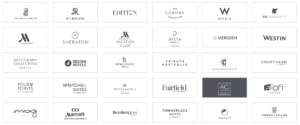There’s no short answer when someone asks you how you build a good brand. Brand building is tough and it requires narrowing down on key attributes. Before you even think of differentiation, you need to first think about your key attributes. Marriott is having a tough time in defining the key attributes of their ‘new’ brand.
Marriott’s Branding Worries
I wrote extensively last week about how Marriott Bonvoy still has a chance to recover. As I was reading through the latest interview that Marriott’s CFO Leeny Oberg had with Skift, I tried to read between the lines. It seemed to be a balancing act. In a way, Oberg tried to acknowledge that Marriott has some problems. On the other hand, Oberg was trying to strike a tone that would sound hopeful.
“It’s about how well we pull the customer in so that they choose our brands as opposed to others,” said Oberg. “The travel landscape going forward is positive because people have a desire for experiences over things, so the importance of Bonvoy being the halo brand makes us feel confident about the future.”
When Marriott acquired Starwood, it aimed to establish the biggest global hotel chain. Clearly, the marketing and the corporate speak indicated so. It was a celebration of their newly established reach and the ability to offer customers more options to stay at hotels in their expanded network.
“It’s about how well we pull the customer in so that they choose our brands as opposed to others,”
This statement is telling because Marriott seems to be banking on its reach to acquire new customers. While location and reach surely matter, mere brand awareness only gets your foot in the door. Building a good brand and reputation requires repeated transactions and engagements, which Starwood elites surely haven’t had post integration.
Post Merger Integration
If you run a search, you’ll find tens of business cases that talk about problems post merger. With the acquisition, Marriott was hoping to serve all those customers who were loyal to Starwood. Instead, they ended up missing Starwood even more.
Defining Key Attributes
Beyond its reach and size, what are the new attributes of the Marriott brand? After the launch of Bonvoy failed, it’ll be interesting to see how they shape up the new brand to earn back customers’ trust. At the moment, nobody is really clear about what the key attributes of this ‘new Marriott’ really are.
M&A Branding
One prominent branding concept can help explain one of Marriott’s major woes. When Alaska and Virgin America merged, Virgin America eventually disappeared. When AA and US Airways merged, US Airways disappeared. Clearly, the respective executives determined that Alaska and American Airlines had better brand equity in each of the cases.
However, in case of hotels it’s a lot more difficult. A single hotel chain has multiple brands under its umbrella. When you talk about Hilton, it’s just just Hilton. It’s Waldorf Astoria, Conrad, Embassy Suites and many more. These brands help Hilton target specific segments of customers. Unlike Airline mergers, Marriott just cannot make all Starwood umbrella brand names go away.
So when Marriott and Starwood merge, what happens? The reaction of Starwood’s elite members clearly shows that they feel that the merger is one step down from the quality of service and benefits they experienced with Starwood. Also, if Starwood elites stayed at Sheratons, W Hotels or Westin’s frequently, those brand names still exist. However, after integration with Marriott, the experience with those brands has diminished in quality. That’s driving a majority of the ire from Starwood elites.
Emotional Connect
When a customer stays loyal to a brand for many years, the brand evokes a strong positive emotion at every mention. This strong emotional connect is built on the basis of repeated positive experiences for the customer.
A positive brand evokes positive feelings. It has a strong emotional connect with loyal customers. Starwood elites have positive connotations and a sense of nostalgia with the Starwood brands they’ve been loyal to for tens of years in some cases. When those expectations are not met, it rightly leaves a sour taste. In conclusion, both Marriott and Starwood brands stand diluted after the merger.
The Pundit’s Mantra
Given all the issues at play, it seems like Marriott will slowly begin its reconstruction phase as it looks to repair all that’s broken. Given its size and scale, I won’t bet on that happening quickly. In the meanwhile, that’ll present competing hotel brands with an opportunity to gain the business of a lot of Marriott/Starwood elites who are unhappy with the Marriott brand.
If you’re a road warrior who stays often at Marriott, you can currently sign up for the Marriott Bonvoy Business Card. Currently, you can earn 100,000 Marriott Bonvoy Points after you sign up and meet the minimum spend of $5,000 in the first 3 months.
What do you think about Marriott’s public statements? As a brand, which move or statement from them would help address some of your concerns as an elite customer who is not happy after the merger?
Also, I intend to dive deeper into the branding side of loyalty programs in the travel industry in subsequent posts. Comment on this post and let me know if there’s a specific travel industry brand that you’d like me to have an in-depth look at.
Never miss out on the best miles/points deals. Like us on Facebook, follow us on Instagram and Twitter to keep getting the latest content!






I qualified for Ambassador level for 2019. After 5 months of mostly lousy service across the board (NOT my Ambassador) I bailed and went to Hyatt where I am about 70 nights from lifetime Globalist to go along with my lifetime Titanium with marriott. hate Hilton, so won’t even bother. At least at Hyatt they pay attention to my profile: extra towels are always waiting in my room, my bed always has feather pillows and I always get a top floor. They really seem to care where as the majority of Marriotts (and yes, I’m including Starwood properties) could care… Read more »
Thanks for sharing your experience. Personalization goes a long way in attaining the loyalty of your most elite customers. I’ve had positive experiences with Hilton and Hyatt whenever I’ve stayed with them over the years. In a way, these experiences have kept me loyal and I haven’t considered switching to the erstwhile SPG or now Marriott over the last decade.
As a Starwood Platinum for some years, I’m sorely disappointed with Bonvoy. After a great introduction, Marriott has done just about every possible wrong thing, way too many things to be an accident or a coincidence. I’ll spare you the laundry list since I’m sure you know it, but in short Marriott views the customer as the enemy. I’m titanium this year, and due to using up air & hotel package hotel nights, getting credit card nights, and having a few stays, I’ll make platinum for next year. It’ll be my last with any meaningful status. I’ll stay at a… Read more »
Thanks for sharing your experience. I’ve stopped flying a major US airline after many years of never feeling valued as a customer. I’m a lot more picky about flying particular airlines, be it for domestic or international routes. Loyalty should ideally cut both ways.
I was optimistic when the merger was announced, but I see no benefit without completing the timeshare merger. I cannot get a straight answer as to when or even if that is going to happen. Without the timeshare merger, I see only diminished customer appreciation and service.